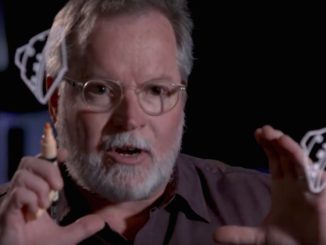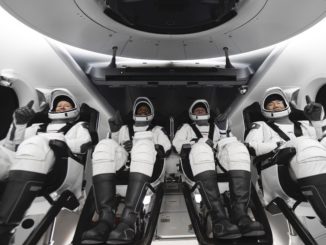EDITOR’S NOTE: Updated at 6 a.m. EST (1100 GMT) Saturday with abort test launch delay.
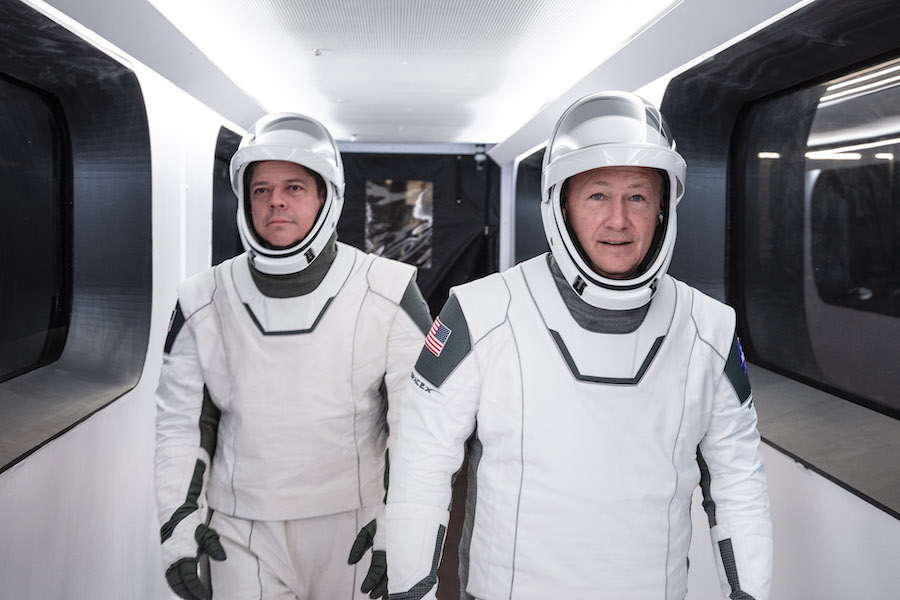
A NASA official said Friday that SpaceX’s Crew Dragon spacecraft could be ready to ferry astronauts Doug Hurley and Bob Behnken to the International Space Station as soon as early March, pending the results from a major demonstration of the ship’s launch abort system this weekend, a pair of parachute drop tests, and space station crew schedules.
Kathy Lueders, head of NASA’s commercial crew program, told reporters Friday that the Crew Dragon capsule slated to carry Hurley and Behnken into orbit on the so-called “Demo-2” mission could be ready for for flight within a couple of months.
“The vehicle will be all ready at the end of February,” Lueders said. “We’re kind of shooting for early March, right now, from a planning perspective. That would be the earliest.”
That schedule hinges on a good outcome of a Crew Dragon high-altitude launch abort test planned Sunday over the Atlantic Ocean east of Florida’s Space Coast. The abort test was delayed from Saturday due to rough seas and winds in the capsule’s downrange recovery zone.
NASA and SpaceX also plan to perform two more full-scale drop tests of the Crew Dragon’s parachutes beginning in mid-February using a boilerplate version of the spacecraft.
The outcome of those tests, coupled with data reviews to analyze their results, will ultimately drive when NASA is comfortable with flying its astronauts on the Crew Dragon spacecraft. And space station managers will also have input into the schedule to determine when Demo-2 flight best fits in the orbiting laboratory’s busy schedule of visiting vehicles.
“We’re obviously trading lots of different things, including what’s going on on (the) station, and when’s the right time to be able to provide crew coverage for ISS also, because crew on ISS right now is very valuable, so having additional hands — and Doug and Bob are additional hands — that’s going to be a very big deal,” Lueders said.
SpaceX plans to launch a Crew Dragon capsule — without any astronauts — aboard a modified Falcon 9 rocket from pad 39A at the Kennedy Space Center during a six-hour window opening at 8 a.m. EST (1300 GMT) Sunday. Around 84 seconds after liftoff, the Crew Dragon’s SuperDraco engines will ignite to push the capsule off the top of the Falcon 9 rocket, simulating a maneuver to quickly carry astronauts away from a failing launch vehicle.
The in-flight launch abort capability is a crucial part of the Crew Dragon safety system. SpaceX verified the Crew Dragon’s ability to escape an emergency on the launch pad in 2015 during a ground-launched pad abort test.
“Tomorrow’s test is one of these things that’s actually going to allow us test that whole system end-to-end,” said Benji Reed, SpaceX’s director of crew mission management.
“The main objective of this test is to show that we can carry the astronauts safely away from the rocket in case anything’s gone wrong,” Reed said.
The Crew Dragon capsule will trigger an abort command shortly after the Falcon 9 passes the point in its ascent where it undergoes the maximum aerodynamic stress. The eight SuperDraco engines will ignite with nearly 130,000 pounds of thrust and burn for nearly 10 seconds, while the Falcon 9’s first stage will automatically shut down its Merlin engines.
The booster is expected to break apart from aerodynamic forces, and leftover propellant in the rocket could ignite in a fireball visible from the ground, assuming clear skies, Reed said.
Meanwhile, the Crew Dragon will reach a top speed of Mach 2.3 and arc on a ballistic trajectory to a peak altitude of some 138,000 feet (42 kilometers), then use its thrusters to re-orient for descent. The capsule will jettison an unpressurized trunk section and deploy four main parachutes to gently splash down in the Atlantic Ocean around 20 miles (32 kilometers) offshore, where U.S. military, NASA and SpaceX recovery teams will recover the capsule to practice procedures they would execute on a crew mission.
The entire abort test flight, from liftoff through splashdown, will take around 10 minutes.
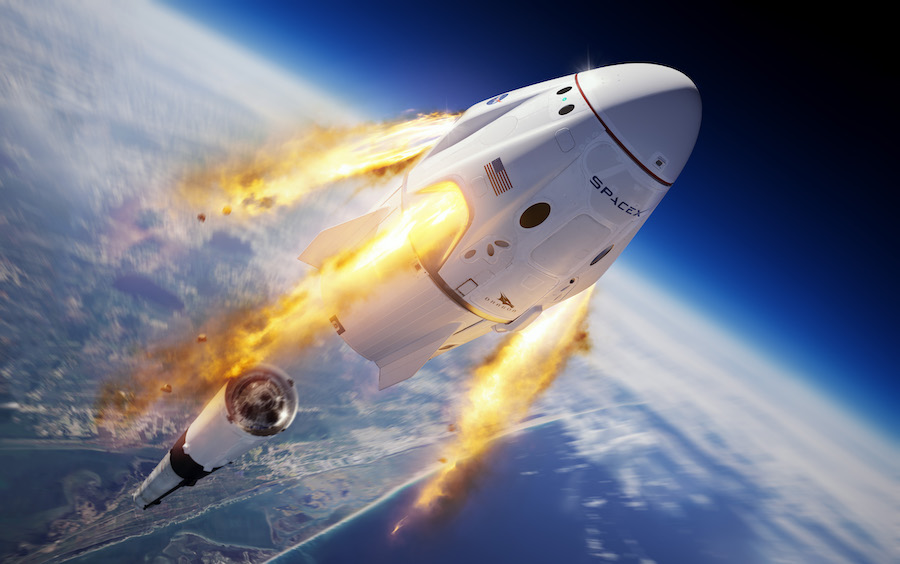
The In-Flight Abort Test is the last major planned test flight of a full-up Crew Dragon spacecraft before NASA clears the vehicle to carry astronauts.
According to Reed, SpaceX is finishing up work on the Crew Dragon capsule assigned to the Demo-2 mission at the company’s headquarters in Hawthorne, California.
“We just recently completed heat shield mate, where we attach the heat shield to the spacecraft, and we’re on track for completing the vehicle and delivering it later this month from Hawthorne to the Cape (the Kennedy Space Center),” Reed said. “There are number of checkouts that we do as part of that process.”
The Crew Dragon will be outfitted for Hurley and Behnken’s mission, filled with propellant for its maneuvering thrusters and abort engines, then mated with a Falcon 9 booster before liftoff from pad 39A.
Amid the hardware checkouts in Florida, NASA engineers will reviewing data packages submitted by SpaceX to verify the Crew Dragon meets the space agency’s safety requirements. NASA officials have not said how long that process will take.
Lueders said SpaceX will conduct two more drop tests of the Crew Dragon’s Mark 3 parachutes, which were strengthened after an earlier chute design failed during testing. The Mark 3 chutes are also flying on the Crew Dragon for Saturday’s abort test.
Read our earlier story for details on the parachute issues, and other reasons for delays in SpaceX’s Crew Dragon development.
“We’re getting ready to do, working with SpaceX … a couple more system-level tests with brand new chutes,” Lueders said. “We’d like to really characterize getting a brand new chute system and getting a couple of tests. So we’re working on that with SpaceX.”
The Mark 3 parachutes aboard the Crew Dragon spacecraft for Saturday’s abort test have flown before.
“So what we’d like to do is, you really want to know what’s your initial capability,” Lueders said. “We’re very happy with the strength and capability of the chutes, but what we’d really like to do is go take a brand new set of chutes straight off the shelf, never used — same design that we’ve been testing, but just made — and then run some tests with that.”
SpaceX announced last month that it completed its 10th consecutive successful multi-parachute drop test using the Crew Dragon’s new Mark 3 parachute design.
In a tweet Dec. 29, SpaceX founder and CEO Elon Musk wrote that the Crew Dragon spacecraft assigned to the Demo-2 mission should be at Cape Canaveral and “physically ready” for flight in February.
“But completing all safety reviews will probably take a few more months,” Musk tweeted.
At the end of a typical mission, the SpaceX crew capsule will splash down in the Atlantic Ocean around 27 miles (44 kilometers) off Florida’s east coast, allowing astronauts to return to port on a boat within a few hours of landing.
SpaceX is developing the Crew Dragon under a $2.6 billion contract awarded by NASA’s commercial crew program in 2014. NASA also has a $4.2 billion commercial crew contract with Boeing to develop the Starliner spaceship.
In 2014, NASA and company officials aimed to have the commercial crew capsules ready to carry astronauts in 2017. But delays in both programs have pushed back that milestone.
One of the two new commercial crew spaceships will be the first U.S. vehicle to fly astronauts to orbit since the retirement of the space shuttle in 2011. Since then, NASA has purchased rides on Russian Soyuz spacecraft to fly U.S. astronauts to and from the space station, paying the Russian government more than $80 million per round-trip ticket in the space agency’s last Soyuz seat contract.
The onset of regular commercial service with the new SpaceX and Boeing spaceships will end U.S. reliance on Russia for crew transportation. But U.S. astronauts will continue flying on Soyuz capsules through an “in-kind” no-funds-exchanged arrangement with Roscosmos, the Russian space agency, in which Russian cosmonauts will also launch and land on Crew Dragon and Starliner capsules.
Lueders said the duration of Hurley and Behnken’s stay at the space station has not been decided.
“Right now, we’re focused on when this vehicle going to be ready, and then we’ll be working together as an agency and with SpaceX about how do we best use it,” Lueders said. “But the first thing I’ve got to do is get through this test, and then we’ll go look at it, along with the other tests we talked about — the chute tests and other things.
“And then when we get a better idea of when the vehicle is really going to be ready to fly, we’ll go look at and work with the space station program — and obviously NASA leadership — on what’s the best way to use this capability.”
The space station is usually staffed with a crew of six, but NASA’s contract with Roscosmos for Soyuz seats expires later this year.
A three-person crew — Russian cosmonaut Alexander Skvortsov, Italian astronaut Luca Parmitano and NASA flight engineer Christina Koch — is scheduled to depart the space station in a Soyuz spacecraft and return to Earth on Feb. 6.
That will leave a team of three — commander Oleg Skripochka and NASA astronauts Jessica Meir and Andrew Morgan — living and working on the International Space Station until the next Soyuz crew launch scheduled for April 9.
Russian commander Nikolai Tikhonov, flight engineer Andrei Babkin and veteran NASA astronaut Chris Cassidy are training for the April 9 Soyuz launch, briefly boosting the station’s crew complement back to six for around a week until Skripochka, Meir and Morgan are scheduled to undock and land in their Soyuz spaceship.
That will leave a three-man crew on the station, with Cassidy as the only crew member to operate experiments and maintain hardware on the U.S. segment of the orbiting research complex. The crew downsizing will limit NASA’s ability to perform spacewalks, except in the case of an emergency, when a Russian cosmonaut could accompany Cassidy to conduct repairs outside the station.
Cassidy is flying in the final Soyuz seat under NASA control before the start of commercial crew transportation services, but NASA Administrator Jim Bridenstine has said the agency could purchase additional Soyuz seats to ensure U.S. astronauts maintain access to the space station through early 2021.
Cassidy and his crewmates are scheduled to land in October after a six-month mission, and NASA has not paid for a seat on the next Soyuz mission late this year.
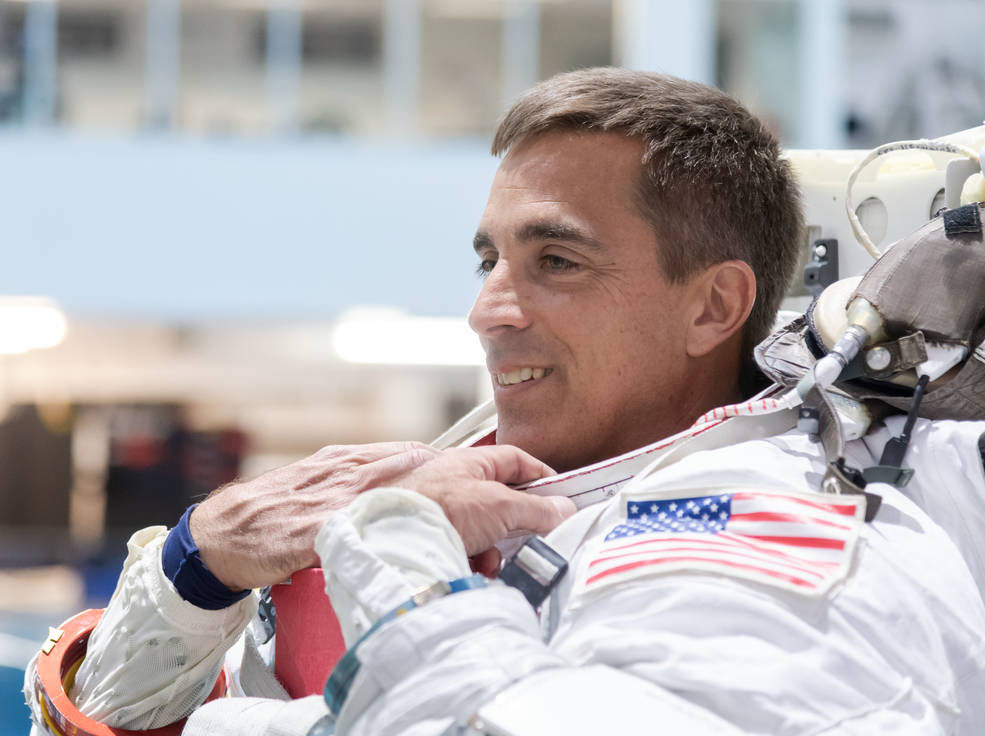
NASA is seeking to address concerns about a possible gap in U.S. crew access to the station by extending the length of the Crew Dragon and Starliner test flights, which originally were expected to last just days or weeks. The piloted demonstration missions will pave the way to NASA’s final certification of both commercial crew capsules, and SpaceX and Boeing could begin operational crew rotation missions late this year, assuming no additional delays.
Boeing’s first piloted Starliner mission, which the company calls the Crew Flight Test, has already been approved to stay at the space station for up to six months. Boeing astronaut Chris Ferguson, a former NASA space shuttle commander, will be joined on the Starliner’s Crew Flight Test by NASA astronauts Mike Fincke and Nicole Mann.
Late last year, NASA officials said they were also considering an extension to the Crew Dragon’s Demo-2 mission.
“We have been working with SpaceX to have the capability for an extended mission for a while — the same thing that we’ve been working with Boeing, too,” Lueders said Friday. “We want to make sure that we are providing the capability to have additional crew presence if we need them … We’re going down to NASA crew member on station.”
Operational flights by Starliner and Crew Dragon spacecraft could last up to 210 days, with the vehicles remaining at the space station to serve as escape pods.
The launch schedule for Boeing’s Crew Flight Test is uncertain as engineers assess the results of the Starliner’s first unpiloted orbital test flight in December. A wrong setting on a mission elapsed timer on the Starliner spacecraft caused the capsule to miss a critical orbit insertion maneuver minutes after an otherwise-successful launch on a United Launch Alliance Atlas 5 rocket Dec. 20.
The error prevented the Starliner from docking with the space station as planned, and NASA officials are determining whether Boeing should conduct another unpiloted Starliner demonstration flight to complete the unaccomplished test objectives on the December mission.
The Starliner safely landed Dec. 22 in New Mexico to complete the abbreviated test flight.
“We have an anomaly investigation team going on right now,” Lueders said Friday. “We also have our post-flight review teams that the program is doing. We’re looking at both of those, and then we’re going to get together in February and say, ‘OK, what do we need to do to get to Crew Flight Test’.
“And that may be go do another uncrewed demo,” she said. “But there are other options, too … There are always lots of options. People do lots of different things to prove out spacecraft.”
Email the author.
Follow Stephen Clark on Twitter: @StephenClark1.

